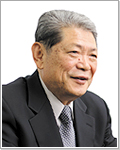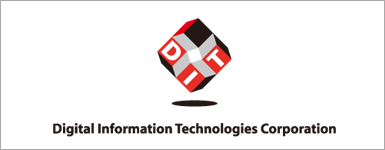| Digital Information Technologies Corporation (3916) |
|
||||||||
Company |
Digital Information Technologies Corporation |
||
Code No. |
3916 |
||
Exchange |
TSE 1st Section |
||
Industry |
Information and communications |
||
President |
Norikazu Ichikawa |
||
Address |
FORECAST Sakurabashi, 4-5-4 Hatchobori, Chuo-ku, Tokyo |
||
Year-end |
End of June |
||
URL |
|||
*The share price is the closing price on March 23. The number of shares issued was taken from the latest brief financial report.
ROE and BPS are the values for the previous term. |
||||||||||||||||||||||||
|
|
*The forecast is from the company. A 2-for-1 share split was implemented on October 1, 2016. EPS and BPS were retroactively recalculated.
*From FY 6/16, net income is profit attributable to owners of the parent. Hereinafter the same will apply. This Bridge Report introduces the first half of fiscal year June 2018 earnings results of Digital Information Technologies Corporation. |
| Key Points |
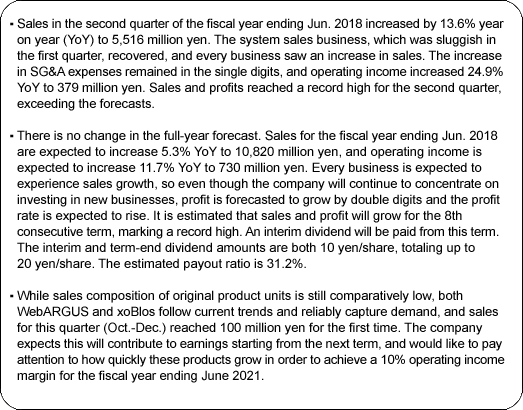 |
| Company Overview |
|
In 1996, he was appointed president of Toyo Computer System, Inc. as the successor to one of his acquaintances. He expanded its business area starting from business system development, and then computer sales business(current: system sales business), embedded product development validation business and operation support businesses tuning Toyo Computer System Inc. into a multifaceted and diverse IT company. In 2002, he established Toyo IT Holdings Corporation, which is the predecessor of current Digital Information Technologies Corporation, by separating several companies under the same group and establishing subsidiaries with 100% ownership. In 2006, he integrated four subsidiaries into one company and renamed it to the current company name. In addition, in January 2011, he established DIT America, LLC in Kansas, U.S.A. Digital Information Technologies Corporation was listed on JASDAQ of Tokyo Stock Exchange (TSE) in June 2015, listed on the second section of TSE in May 2016 and listed on the first section of TSE in March 2017. 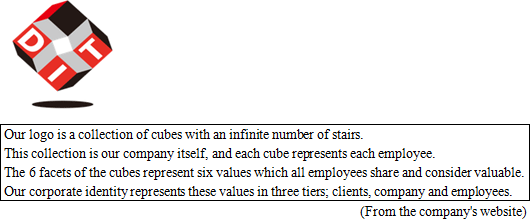 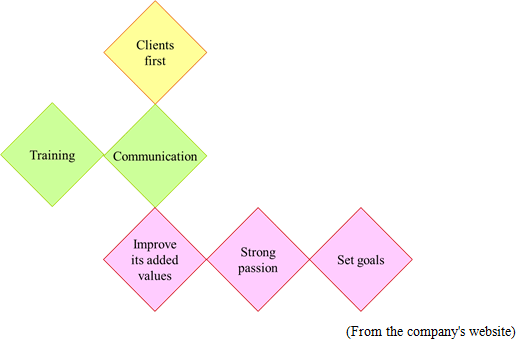 Employees are to uphold this company policy as their creed and follow these principles at all times. 1. Segments
There are two segments: software development business and system sales business. The software development business consists of 3 business units: business solution unit, embedded product solution unit and original product business unit.
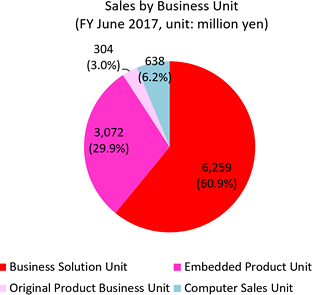 (1) Software Development Business
The sales for this business unit is mostly from custom development for end-users and information systems companies which are clients'subsidiaries in a wide variety of industries including finance, communications, distribution and transportation as well as for leading SI vendors.1) Business Solution Unit (Business system development unit) Specifically, development for websites and key systems, front and back office operations, new system development and maintenance development with technologies developed in each area. The company has developed trustworthy relationships with leading companies in each area which enables them to secure stable orders. (Operation support unit)
Main clients include communications carriers, total human service corporations and information system companies which are airlines subsidiaries.This "business unit to support clients'daily operations through IT" has stable revenue as it is an ongoing business in line with the business website domains of leading companies. Specific business includes: 2) Embedded Product Solution Unit
This business unit is trusted by leading manufacturers to directly develop custom software for in-vehicle devices, mobile devices, information home appliances and communication devices. For in-vehicle devices, mobile devices and information home appliances, the unit develops custom software for overall systems including firmware, device business unit controls and applications.(Embedded product development unit) It focuses on Auto-Drive related field with new technology, as well as infotainment for in-vehicle devices as the demand for this market is expected to grow. In addition, it undertakes software development for wireless base stations and communication module devices for communication devices. (Embedded product verification unit)
This business unit verifies and makes suggestions to improve qualities and functions of products through its verification service.It provides verification services domestically and internationally (North America, Asia, Europe, etc.) including laboratory tests using specialized devices to verify product operation and function, field tests to verify products in the actual environments, as well as overall system tests conducted as the final quality verification from the perspectives of the third party. Some of the overseas field tests are designated to its subsidiary, DIT America, LLC, which provides fast service with verification of product usability from the perspective of local staff. The range of products for verification includes in-vehicle devices, medical devices, communication devices and mobile devices. 3) Original product business unit
The company develops and sells its original products as a growing business, using its unique technology.Currently, the company strongly focuses on the sales of two products, "WebARGUS," a website security solution, which detects tampered website simultaneously as it occurs and instantly restores the original normal condition, and "xoBlos," an Excel work innovation platform, which features data decomposition and restoration as well as meeting various forms of data business processing needs. There are other products such as "APMG (Anti Phishing Mail Gateway) ," a solution to prevent damages from phishing and illegal use of brands by automatically adding electronic signatures on e-mails, and "Rakuraku page," a CMS (content management system), which enables editing and updating websites easily. (2) System Sales Business
The company and its subsidiary, Toyo Infonet Co., Ltd, sell "Rakuichi," a business support mission-critical system, for small and medium enterprises, manufactured by Casio Computer Co., Ltd.The sales area is started at Kanagawa first and expanded to Tokyo, Chiba, Gunma and Ehime successively. The Company provides substantial support for their users to increase the client retention rate. In addition, they set up a call center to attract and build a new client base. The number of sales for "Rakuichi" has been recorded to be the highest across all agencies for 13 consecutive years. 2. Main Strategic Products
1) "WebARGUS," a new website security solution
WebARGUS is a new security solution which detects tampered websites instantaneously and immediately restores it to its original state. By detecting and restoring immediately when incident occurs, WebARGUS protects corporate websites from damage caused by malicious and unknown cyber-attacks and simultaneously prevents the escalation of the damage from viruses spreading via the tampered website.
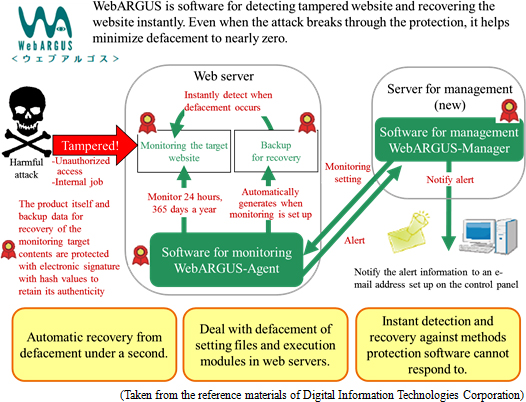 ◎ Increasing tampering of websites
According to the research conducted by "JPCERT Coordination Center," (*) tampered websites reported to the center was 3,274 in fiscal 2016 (April 2016 to March 2017), smaller than 7,724 cases in 2013, but it is still at a high level.
"JPCERT Coordination Center" (*): This center receives reports concerning computer security incidents including hacking via internet and service disturbance in Japan. It also supports measures, grasps how the problems are generated, analyzes the methods, investigates and advises on measures to prevent recurrences from a technical point of view.
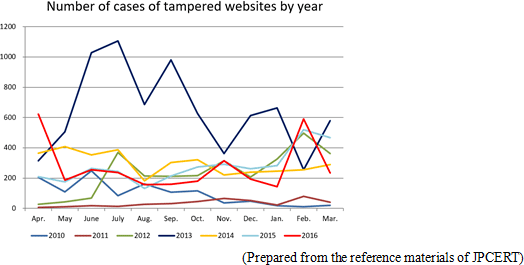 ◎ The background of the development of "WebARGUS"
Under these circumstances, the company, which had already released a solution called "APMG" to prevent damage from phishing and illegal use of brand by automatically adding electronic signature in e-mails, started developing "WebARGUS," based on a core security technology in the spring of 2013, after 2 years of research. Then in July 2014, it released "WebARGUS."The major characteristic and strength of the company is that it has a variety of rich IT related technologies, and has a highly standardized core security technology. This is because its engineers have a mindset to embrace challenges and are not afraid to take risks. Thus, they are not satisfied with just developing custom products. This is strongly influenced by the company's organization strategy represented by its corporate culture and in-house company system which will be explained later in this report.  On the other hand, if "WebARGUS" is installed, because it instantly detects and restores websites when tampered with, the condition of a website can be maintained in the normal state. Thus, the website does not need to be disabled in a rush when the application detects a threat. Companies can concentrate on pursuing the cause and strengthening protection while its website is kept open to public. Most of the detection software detects tampered website with a periodic monitoring on pre-configured, specified timing or intervals. With this method, there will be a time lag between when the website is tampered with and when it was detected, so it is inevitable for the website to be tampered. In addition, if the interval is shortened to reduce the time lag, there are other challenges such as increasing CPU load. On the other hand, when some kind of event occurs (such as data deletion or addition excluding browsing), "WebARGUS" conducts real time scanning to detect the event. The major feature of this product is that it is also equipped with an instant restoring function which enables restoration to the original state in less than 0.1 seconds after the detection (average time under the demo environment: 0.003 seconds per file). This instant restoration is its unique technology. The annual license fee of "WebARGUS" is JPY480,000 (excl. tax) per OS with support. This also includes free update modules for minor version updates. ◎ Introduction and sales
When WebARGUS was released, the sales growth was rather slow because general understanding of website security was mainly about protection against hacking into a computer system and awareness about "tampering" was limited. However, the acknowledgment that "software for detection is needed as well as for protection" is growing rapidly due to the more frequent mentioning of the independent administrative agency, "IPA (Information Processing Association)," taking measures to prevent defacement. This agency is established to support the IT national strategy from a technical and personnel aspect perspective and is supervised by the Ministry of Economy, Trade and Industry.In addition, "Revised Points for the Cyber-Security Management Guidelines" were announced on November 16, 2017, to which the Ministry of Economy, Trade and Industry added a new key aspect: construction of a system to handle cyber-security risks, including functions such as threat detection and restoration. Because of this, inquiries to the company increased further. Under these circumstances, the company has carried out promotion and marketing including organizing seminars for target users who recognize the necessity for a higher level of security, and participation in exhibitions. It focuses on agency sales to strengthening marketability. There are currently a total of 29 companies with agency contracts. They have been actively involved in development collaborations with data centers and cloud service corporations. Furthermore, the company is expected to expand its business overseas as well as product sales in Japan. The company is preparing to provide support for the tampering of websites across the globe. ◎ Strengthening the feature of merchandise
Initially, WebARGUS was only available for Linux, but a Windows version was released in April 2016, and an enterprise edition in September 2017. In February 2018, the company began offering a next-generation cloud WAF (WebARGUS Fortify), which dramatically strengthens the functionality of comprehensive web security. In particular, because of the release of the enterpriseedition, which was targeted at large-scale companies, an increasing number of large companies (mainly listed companies) adopt WebARGUS.In addition, the company is considering expanding the range of applications in anticipation of security measures for the IoT generation, including WebARGUS for embedded systems products. In particular, an official project has been launched for the embedded version, and the company continues to discuss business and conduct technical research with the goal of commercialization. 2) "xoBlos," an Excel work innovation platform
Even in advanced corporations with a high level of IT, there are numerous Excel-based tasks including manual operations in the office. Most non-routine tasks consist of repetitive manual operations such as processing Excel reports by manually inputting data from paper reports, aggregating totals from multiple Excel sheets and visualizing and analyzing CSV data extracted from packaged system.The company's original-brand, "xoBlos," entirely automates these inefficient Excel-based tasks and provides drastic improvements to workflow. 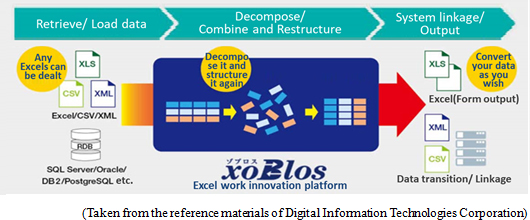 ◎ Background of development
Many corporations use Excel, the major spreadsheet software, for generating quotations and invoices. However, in cases where they generate these documents in different formats for each client according to the clients'requirements, manual input is mandatory because it is difficult to tally, sort and analyze in a systematic way.For this, the company developed "xoBlos," an Excel work innovation platform, to automate tasks and significantly improve workflow efficiency.  Indeed, the times have caught up with xoBlos and the company. Also, in order to strengthen product appeal, in February 2018 the company began offering "xoBot," which improved automatic processing in Excel even further. xoBot, in addition to specializing in Excel processing, is a platform product that further improves automatic processing by forming a link with RPA (*) products and other systems. After xoBot Solo, an automated business platform that runs on PC clients, in August, the company plans to release another automated business platform, xoBot corabo, which will run on web servers. The company plans to use the opportunities created by xoBot to provide new products and services based on xoBlos technology, which will be marketed as xoBlos 2.0 and plans to expand sales promotions for the new products. * RPA (Robotic Process Automation) RPA refers to efforts to automate work by using robots, and mainly deals with white-collar work in back offices by using AI (artificial intelligence) and "machine learning," in which AI learns through repetition. It is capable of processing across a variety of applications, such as software, browsers, and cloud environments, by simply inputting the processing procedures normally done by humans into the operation screen. * A sample use case: Sumitomo Forestry Group "Reduced the number of work hours needed for budget aggregation by 180 hours per month"
(Excerpt/summary by Investment Bridge with reference to the materials of the company)The Sumitomo Forestry Group consists of more than 100 subsidiaries and affiliated companies, centered on Sumitomo Forestry Co., Ltd. (TSE 1st Section, 1911), whose two main pillars are lumber building materials and building new custom houses. It is a large, diversified corporation, expanding into fields such as environmental resources, overseas business, and real estate brokerage. In the term ended March 2017, its sales were 1.1 trillion yen, and operating income was 53.9 billion yen. Full-scale introduction of xoBlos began in May 2014. (Situation prior to introducing xoBlos) The business performance management group from the Planning Department at Sumitomo Forestry Co., Ltd.'s housing headquarters was in charge of sales management and account settlement for the housing business, and estimating the monthly profit/loss and deciding on the annual budget was a heavy burden. Data on the estimated profits/losses of 160 organizations were sent monthly by email from each site, and the person in charge then pasted them into an Excel spreadsheet, consuming half a day's time. It was troublesome and mistakes tended to occur, and in the case of formulating an annual budget, hundreds of entries were required for each site, which required a large amount of manpower to tally them up. In addition, at one of the company's subsidiaries, Sumitomo Forestry Information Systems Co., Ltd., the budget totals were distributed across Excel spreadsheets on 5 or 6 different computers and processed, therefore it took the entire day to obtain a result and thus no other work could be done in the meantime. (After introducing xoBlos) Introducing xoBlos resulted in the anticipated effect. - Training was not particularly necessary as usability were not changed from those in Excel, and only a simple manual was provided. - Previously, the user extracted the monthly data from the core system and transferred the entries one by one, but because xoBlos can integrate with the core system in order to extract the data, it could be done with only one click, and the number of mistakes during transfer fell to zero. - By eliminating two hours of work at each branch, they were able to cut 120 hours in total. Also, summing up the totals at the headquarters took only 5 minutes to complete, and mistakes could be eliminated. - In the conventional budget compilation system, it takes 1 to 2 minutes to update one total, but with the Excel-like xoBlos, the same task was finished in only 1 to 2 seconds. - There are 700 technical (carpentry) positions at Sumitomo Forestry Home Engineering Co., Ltd., which carries out the construction and supervision of custom wooden houses as a group company. It uses a self-assessing skill map sheet to determine what kinds of skills and qualifications are held, and it uses xoBlos to compile. Until now, individuals kept the previous year's skill map sheet and reassessed them each year, but by using xoBlos, it became possible to distribute the previous year's sheets and fill them out while referring to past records. Of course, submission can also be completed with just one click, and distribution can be verified using the aggregation function, so it is easy for the company to analyze the current status of important skills. Sumitomo Forestry, which introduced xoBlos in 2014, has 11 different necessary work operations related to budget and profits/losses. As a result of advancing RPA in 2015, nine of the eleven tasks are now performed by robots, allowing a reduction of 60 work hours per month. The tasks include: 1. Log in to the accounting system, download and save a record of expenditures; 2. Log in to the housing system, download and save a record of sales; 3. Log in to xoBlos and load the record of expenditures into a spreadsheet; 4. Load the record of sales into a spreadsheet; 5. Print spreadsheets for the previous month's results and next month's forecast; 6. Log into xoBlos, finalize the forecast spreadsheet; 7. Prepare figures on results and forecasts for materials to be used in meetings; 8. Report the forecast to headquarters; and 9. Send meeting materials to participants via email. In addition to the 120-hour reduction made possible by xoBlos, combining it with RPA ultimately enabled Sumitomo Forestry to reduce working time by a total of 180 hours per month. At Sumitomo Forestry, in addition to the results of xoBlos, DIT's rapid support system is highly evaluated, and there are plans to further utilize xoBlos throughout the group. ◎ Introduction and sales
Currently, there are over 300 companies with "xoBlos."The company has been expanding sales including hosting seminars jointly with one of its major agencies, Daiko Denshi Tsushin, Ltd (8023, the second section of TSE), by taking full advantage of its wide variety of clients, branches and marketability. Initially, the company was mainly making introductions to medium-sized companies, but as the need for efficiency in on-site work has increased, there have also been more introductions to large companies. Currently, about 70% of newly introduced companies are large companies. The company holds a seminar for sales promotion three times per week, and on most occasions every seat is filled. 1) Multifaceted and diverse IT company
The company has expanded its business areas by flexibly responding to the progress of information technology, from business system development business to computer sales(current: system sales), embedded product development and verification business, and operational support business as well as working on its original products based on its technical strengths which have been developed during the process of business expansion.One of the major characteristics of the company is that it is a multifaceted and diverse IT company and has a wide range of business activities and provides own-brand product with originality. 2) Organizational strategies of partial and total optimization
Another significant characteristic of the company is that it has an organizational strategy with two opposite factors, partial and total optimization in a well-balanced manner.For partial optimization, the company has specialized companies under an in-house company system which aim to be the best in each field. It also provides training and produces entrepreneurs with innovative spirits. For total optimization, the company pursues synergy between companies while respecting independence of each in-house company; through scrap and build done by the headquarters, collaboration between each in-house company and development of new business areas. 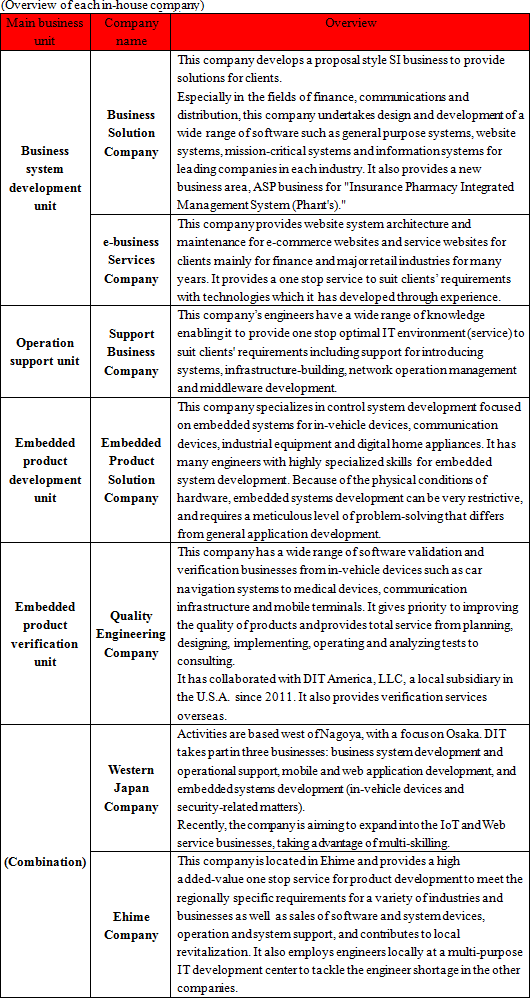 3) Development and sales of original own-brand products
As mentioned above, the company has developed a variety of original own-brand products like "WebARGUS" with itsunique technologies. They are growing to be the primary source of revenue in the future.
|
| The First Half of Fiscal Year June 2018 Earnings Results |
 Both sales and profit increased. A new high was established for the second quarter.
Sales increased 13.6% YoY to 5,516 million yen. The system sales business, which was sluggish in the first quarter, recovered, and every business saw an increase in sales. The increase in SG&A expenses remained in the single digits, and operating income increased 24.9% YoY to 379 million yen.Sales and profits reached a record high for the second quarter, exceeding the forecasts. 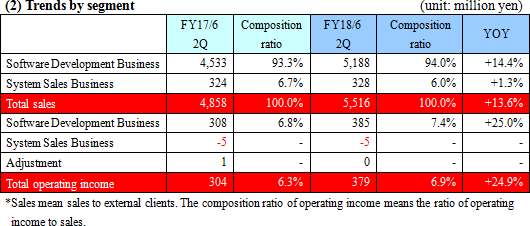  ◎ Software Development Business
Both sales and profit increased.The system development in the fields of mainly finance, and also those for medical care, pharmaceutical products, social infrastructure grew and operation support was healthy. There was a significant increase in sales. Development for in-vehicle applications has been steady for all customer segments and considerably increased. In addition to the development of mobile applications for IoT, in semiconductor-related embedded systems development, software development projects for secure microcomputers have greatly increased. These microcomputers protect data on the in-vehicle network and prevent unauthorized connections to electronic control units (ECU). ◎ System Sales Business
Sales growth and losses are on par with the same period of the previous term."Rakuichi," which is produced by Casio Computer Co., Ltd. for small and medium enterprises, experienced a recovery in sales to repeat customers. Sales of items such as multifunctional devices and network devices, as well as inquiries about original products increased. 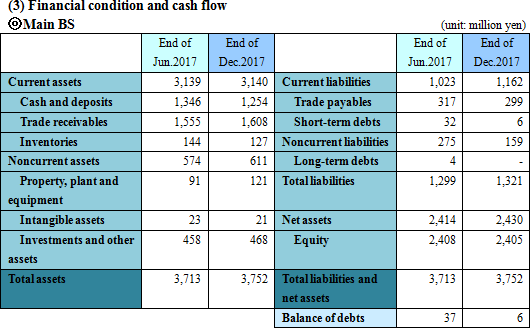 Total liabilities increased 22 million yen to 1,321 million yen due to a decrease in debts, appropriations of allowance for bonus, and a decrease in net defined benefit liability. Net assets increased 15 million yen to 2,430 million yen due to the growth of retained earnings. Consequently, the equity ratio decreased 0.2 points from the end of the previous fiscal year to 64.8%. The balance of short to long-term debts declined 31 million yen to 6 million yen.  There was no longer any income made by issuing shares, but due to the acquisition of treasury stock, the deficit of financing CF expanded. The cash position improved. (4) Topics
Conducted share splitAs of April 1, 2018, the company plans to implement a 2-for-1 share split, with the aim of raising the liquidity of the stock and further expanding the range of investors by lowering the amount per unit of investment. |
| Fiscal Year June 2018 Earnings Estimates |
 Sales and profit are estimated to grow for eight consecutive terms in a row.
Sales and operating income are estimated to be 10,820 million yen, up 5.3% YoY, and 730 million yen, up 11.7% YoY, respectively.Every business is expected to see sales growth, so, even though the company will keep concentrating on the investment in new businesses, profit is forecasted to grow by double digits and profit rate is expected to rise. It is estimated that sales and profit will grow for the 8th consecutive term, marking a record high. An interim dividend will be paid from this term. The interim and term-end dividend amounts are both 10 yen/share, totaling up to 20 yen/share. The estimated payout ratio is 31.2%.  ◎ Business solution unit
Sales are estimated to grow in the fields of mainly finance, and also medical care, pharmaceutical products, social infrastructure, and operation support is expected to be healthy.
◎ Embedded product solution unit
It is forecasted that the demand for development of in-vehicle devices will be strong and the business of development and testing will be healthy. Semiconductor-related embedded systems development projects will progress steadily.
◎ Original product unit
As the demand for security grows and the company follows the trend of shortened working hours and the reform of ways of working, "WebARGUS" and "xoBlos" are estimated to grow considerably.
◎ System Sale Business
As the company actively promotes sales by selling "Rakuichi" to new customers and replacing old products with new ones, sales are forecasted to grow.
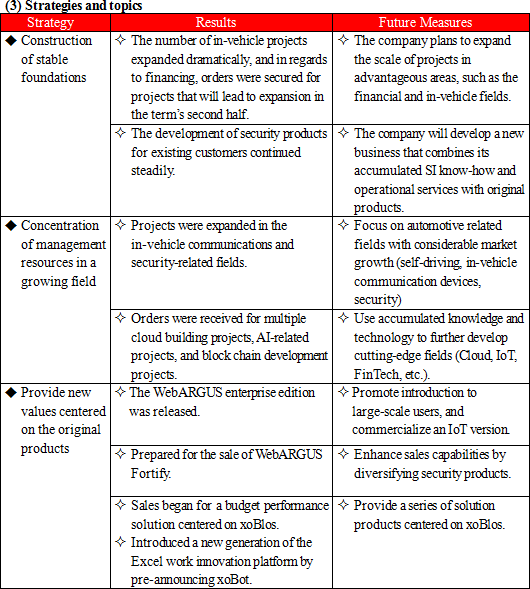 |
| Conclusions |
|
The company expects this will contribute to earnings starting from the next term, and would like to pay attention to how quickly these products grow in order to achieve a 10% operating income margin for the fiscal year ending June 2021. 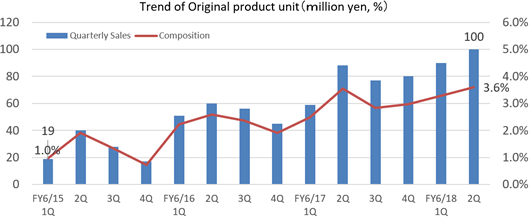 |
| <Reference1 : Regarding growth strategy> |
|
In its business infrastructure, the company will make stable transactions in a wide range of existing business fields to further strengthen its business foundation, and provide new value through growth factors such as original products and other new products. Following "Development" from the second preceding term (ended June 2016), the company has positioned the previous term (ended June 2017) and the current term (ending June 2018) as "Reinforcement," and from the next term onward it will enter "Expansion and Stabilization." As a medium-term objective, the company aims for "Triple 10s," which consists of sales of 10 billion yen, an operating income of 1 billion yen, and an operating income margin of 10%. In regards to sales, it achieved this target in the previous term. 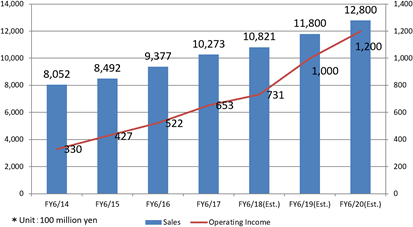  <Growth strategies and results/Future measures>
Growth strategies, results, and future measures to take in each business are as follows.
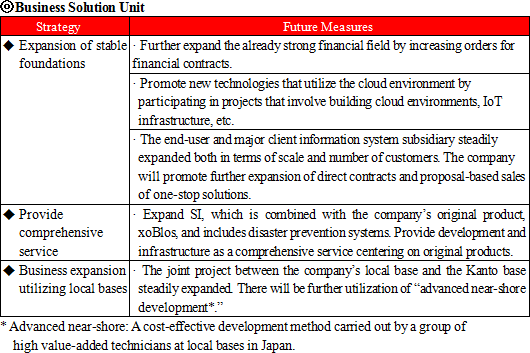 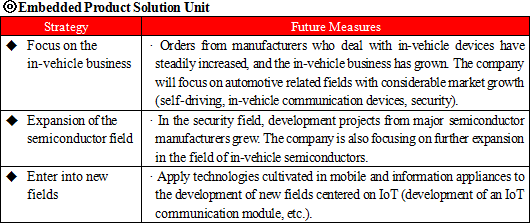 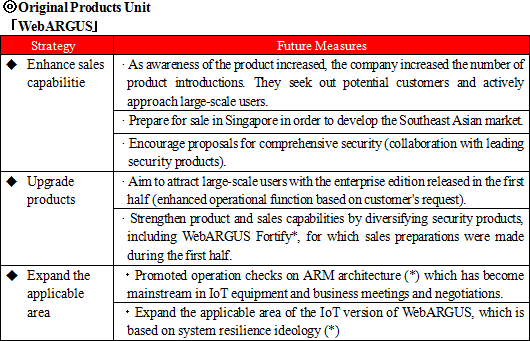 (*) ARM Architecture: A method for designing processors whose intellectual property right is held by ARM in the U.K. and which is widely adopted for semiconductor chips for low power applications such as smartphones and in-vehicle devices.
(*) System Resilience Ideology: To be resilient means to show strength of stability and the ability to recover quickly. In the case of WebARGUS, this refers to the instantaneous detection/restoration mechanism (websites are restored to their original state immediately after tampering is detected.) 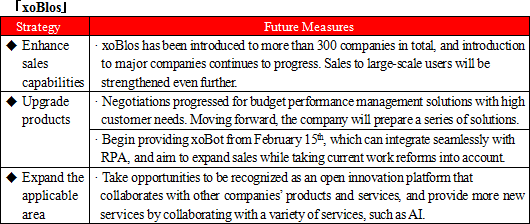 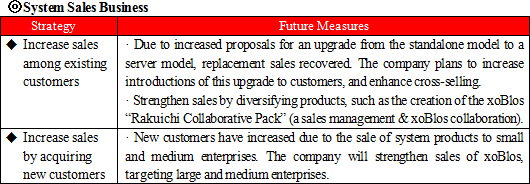 |
| <Reference2 : Regarding corporate governance> |
 ◎ Corporate Governance Report
Last Update: February 14, 2018<Basic principle> The company recognizes that compliance with laws and regulations, maintaining transparency in management, and improving the soundness and sustainability of its corporate value are the most important management issues. In order to tackle these issues and to fulfill social responsibilities to shareholders and other stakeholders, the company has established the following corporate governance system. The company considers it important to further strengthen this system, verify its functions on a regular basis, and implement necessary measures. 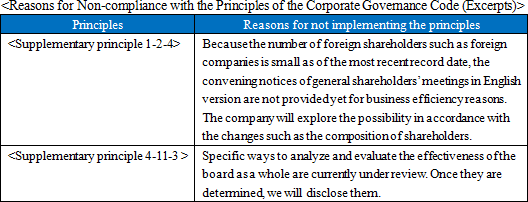 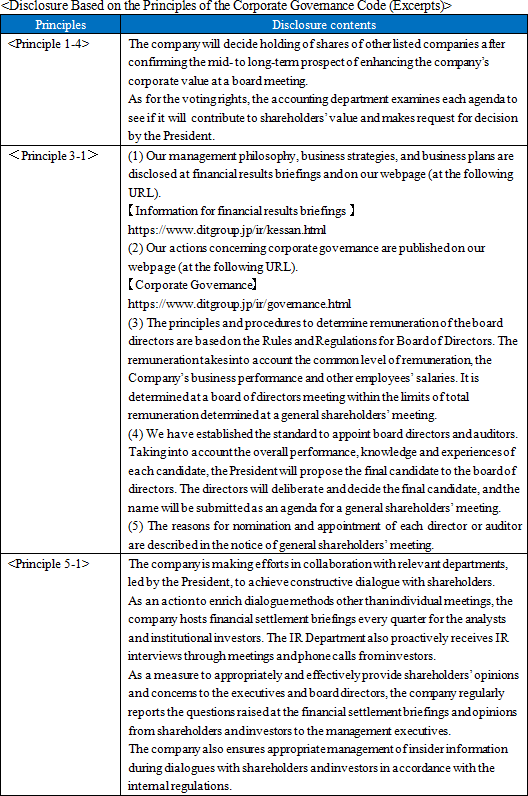 Disclaimer
This report is intended solely for information purposes, and is not intended as a solicitation for investment. The information and opinions contained within this report are made by our company based on data made publicly available, and the information within this report comes from sources that we judge to be reliable. However we cannot wholly guarantee the accuracy or completeness of the data. This report is not a guarantee of the accuracy, completeness or validity of said information and opinions, nor do we bear any responsibility for the same. All rights pertaining to this report belong to Investment Bridge Co., Ltd., which may change the contents thereof at any time without prior notice. All investment decisions are the responsibility of the individual and should be made only after proper consideration.Copyright(C) 2018 Investment Bridge Co.,Ltd. All Rights Reserved. |

